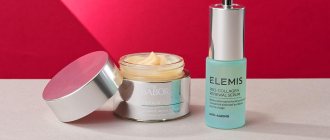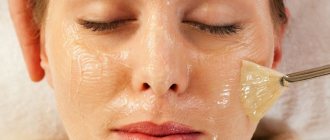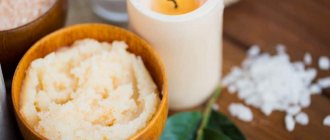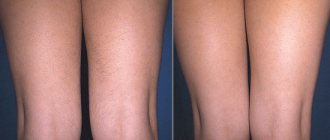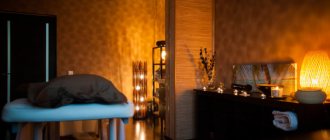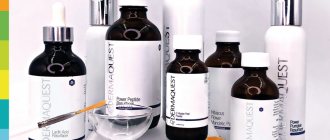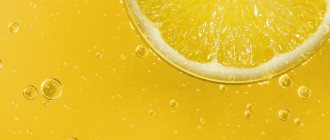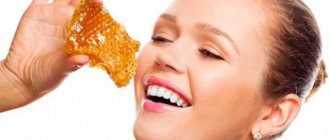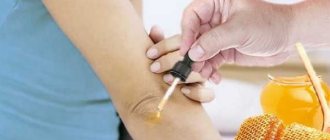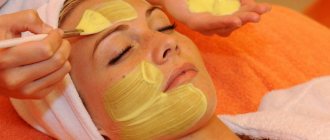Every lady is concerned about the condition of her skin: a woman’s face, arms, legs, and body need careful care. Various cosmetic procedures help eliminate existing imperfections on the skin. Peeling is one of these methods. The procedure renews the skin on the feet and helps get rid of keratinized areas. After all, the beauty of the legs is no less significant for the fair half of humanity than the appearance of other parts of the body.
Peeling is carried out at home or in a beauty salon. The first option will save time and money, but only if you do everything correctly.
Features of foot peeling in the salon and at home
The procedure is aimed at renewing the upper layer of the skin of the feet by exfoliating dead cells that constantly accumulate on the feet as a result of the influence of external factors. In this regard, calluses, cracks and other damage can form, through which infections and pathological microorganisms can penetrate.
Peeling allows you to remove the stratum corneum, thereby allowing the skin to breathe, absorb beneficial elements from creams, and become smooth and elastic. Heels and feet look beautiful and well-groomed.
Contraindications
Everyone wants to show off their smooth and clean feet, but not everyone benefits from exfoliation. An irresponsible attitude towards this procedure, especially when performing hardware peeling, will lead to serious health problems.
Peeling will have to be abandoned if the skin contains:
- Inflammation.
- Scratches, cuts and other damage.
- Insect bites.
- Cracks.
Allergic reactions, dryness and irritation, wounds - all these are possible consequences of improper peeling. Take care of yourself and pay attention to contraindications!
Types of peeling
There are several main types of peeling, each of which has a number of features and advantages.
Mechanical
The most common method of working out the legs, usually used at home. This is done through scrubs and special masks, which contain abrasive particles that affect the skin. It is recommended to use a foot grater and pumice stone at the same time.
Scrubs can contain artificial or natural ingredients - egg and nut shells, sea sand or salt, coffee, clay, rice grains, wax, etc. They exfoliate the skin and help remove dead cells.
The masks may contain cereals, fruits, essential oils, chocolate or dairy products. Due to such ingredients, the skin is moisturized, saturated with minerals and vitamins.
Hardware
This is a type of mechanical peeling, during which special cutters are used - attachments with an abrasive surface. They rotate due to an electrical device. There are several types of attachments, the difference between which lies in the size of the roller and the parameters of the abrasive.
Before you begin the hardware treatment, your legs should be steamed and a softening keratolytic gel should be applied for 5-10 minutes.
Chemical
Chemical or acid peeling for feet allows you to remove dead skin layers on your feet due to the action of acids. The method will be used in beauty salons for deep and medium types of peeling.
The procedure can cause unpleasant and even painful sensations in some cases, so you cannot conduct the session at home, but you need to contact a professional. If necessary, the specialist will pre-administer local anesthesia.
If you decide to carry out acid peeling of your feet at home, then the active composition should have a low acid concentration.
Peeling with fish
A unique exotic method of treating the skin of the legs. Garra Rufa fish are used to remove old cells and massage the feet. The areas of the skin become soft and velvety after the session.
The procedure takes about 15 minutes. It is recommended to carry it out regularly to consolidate the results, although the effect is noticeable after the first visit to the salon.
Fishes
Fish peeling is truly exotic. Garra Rufa is a fish of the carp family, which is common in the waters of Iraq, Turkey, Syria and Iran. You should not be afraid of bites - the fish has no teeth, and it performs all actions with the skin by plucking.
Fish peeling allows you to:
- Get rid of the stratum corneum;
- Improve blood circulation due to a light massage effect;
- Cope with fungus;
- Prevent psoriasis and other dermatological diseases.
How the procedure goes:
- The client dips his feet into a makeshift pool inhabited by fish;
- For 15 minutes, the fish do their “work”, biting off the epithelium ready for detachment;
- Each bite is accompanied by the injection of Garra Rufa saliva, which has a strong softening effect;
- After the procedure, the feet are dried with a towel and lubricated with nourishing cream.
Fish peeling should be repeated 5 to 8 times a month. The cost of one session in different regions ranges from 400 to 100 rubles.
Contraindications to the fish peeling procedure:
- Infectious diseases;
- Malignant tumors;
- Thrombophlebitis;
- Open wounds.
Popular store brands
The modern market offers many different types of compositions for exfoliating dead skin layers of the feet. Both Korean and European brands, as well as domestic products, are popular.
Peeling “Bamboo and jojoba”, Gehwol (Germany)
The composition contains natural ingredients - jojoba wax, honey extract, avocado oil and vitamin E. Thanks to this, cream peeling allows you to:
- effectively but gently exfoliate the skin of your feet;
- give smoothness to the feet;
- activate cellular regeneration processes;
- stimulate blood circulation;
- fill the dermis with nutrients without provoking an allergic reaction;
- prevent early aging of the skin.
Sold in a 125 ml container, the average price is 1,550 rubles.
Snake skin and fat peeling, tianDe (China)
Contains snake fat extract, as well as vitamins C and E. Provides comprehensive care, while simultaneously cleansing and nourishing the skin of the feet. Allows you to remove accumulated impurities in the pores, moisturize the feet, soften the cover and even lighten the skin. According to reviews, after using this peeling, the texture is noticeably smoothed out and wrinkles are reduced.
Price for 100 ml – about 300 rubles.
Peeling with silicon and fruit acid, Premium (Russia)
Contains:
- lactic acid;
- silica;
- essential oil of sweet orange varieties.
As a result of using this composition, the skin exfoliates and softens, becoming more hydrated. The product combines the qualities of abrasive and chemical peeling.
Works very well in cases of corns and hyperkeratosis (excessive keratinization and thickening) of the feet. Recommended for use for the prevention of calluses.
The price for 100 ml of the composition is usually about 500 rubles.
Exfoliant Depilflax (Spain)
Removes rough layers on the legs, softens the skin, smoothes out fine wrinkles, and fights keratosis.
Recommended for use as a preparation for feet before a paraffin therapy session.
A 200 ml container can be purchased for approximately 650 rubles.
Pearl foot peeling Perlmutt-peeling, Gehwol (Germany)
The active composition contains:
- jojoba oil;
- panthenol;
- micropowder of mother of pearl;
- bisabolol;
- sea water.
Perlmutt-peeling from a German manufacturer is approved for use in diabetic foot syndrome.
The price of the composition is about 1400 rubles. for 125 ml.
Peeling socks
Special peeling socks allow you to effectively cleanse the skin of your feet from dead skin particles. These are plastic bags, most often transparent, that need to be put on your feet. The procedure takes time, since the result does not appear immediately, but after several days. The session itself takes about two hours, so it is advisable to set aside time for it in the evening so that you don’t have to go anywhere.
The procedure is carried out as follows:
- First, rinse your feet thoroughly and steam the skin.
- Then special peeling socks are put on your feet - bags filled with an active gel-like composition.
- Next, keep the socks on your feet for as long as indicated in the instructions - usually about two hours. During this period, the skin will absorb the active components of the gel, which will launch the processes of exfoliation and cellular regeneration.
- At the end of the session, wash your feet and apply a moisturizing cream or lotion that does not contain alcohol.
After a few days, you can notice the first results - the skin on your feet will gradually begin to peel off. After a week, the cover will become smooth and soft. A popular brand is Apieu Soft Foot - peeling socks filled with exfoliating gel with aha and bha acids
Benefits for feet from the procedure
The deep cleansing procedure can be carried out both in a beauty salon and at home. The benefits of such a session are:
- high-quality cleansing;
- cellular renewal;
- improving the aesthetic appearance of heels and feet;
- fight against aging of the skin of the legs;
- prevention and treatment of fungal infections of the skin and nails;
- epidermis regeneration;
- treatment of cracks and inflammations;
- nutrition of both the upper and deeper layers of the dermis;
- improving blood circulation in the feet.
Getting rid of hardened particles allows you to make the skin not only externally attractive due to smoothness, elasticity and uniform color, but also remove skin diseases and unpleasant odors.
Enzymatic
In its action, enzyme peeling is similar to acid peeling, but is more gentle and safe. Getting rid of the stratum corneum is done using preparations containing enzymes isolated from plants.
It is most often used in beauty salons, but is relatively safe for home use.
Procedure for enzyme peeling:
- A small amount of fermented product is applied to the skin of the feet. Particular attention is paid to rough areas and spaces between the fingers.
- The legs are wrapped in film for 15-20 minutes;
- Remains of the composition are removed with a damp cloth.
It is strictly forbidden to massage your feet while applying the product and rinse it off with water.
When choosing a drug, pay attention to the Kart Enzyme Product with papaya, apple and peach enzymes.
Recipes for foot peeling at home
For home use, you can prepare special peeling compositions that gently work with the skin, cleanse and moisturize it without causing pain. The recipes for preparing such compositions are simple, so anyone can prepare a homemade cleansing foot mask.
Kefir
Kefir contains natural lactic acid. It is one of the main components used for peeling in beauty salons. This acid actively works to destroy dead cells and activate regeneration processes.
The session is painless and does not cause redness, itching or other unpleasant sensations. The skin becomes soft, tender and moisturized.
To carry out the procedure you need:
- Take half a glass of kefir and heat it to a temperature of 35-38 degrees in a steam bath.
- Place two plastic bags on your feet and pour heated kefir into them.
- The bags should be secured with elastic bands so that they do not fall off your feet, and regular warm socks should be worn on top.
- Leave the mixture on your feet for two hours. It is advisable not to walk at this time.
- Remove the mask from your feet, rinse your feet with water and moisturize your skin with nourishing cream.
Coffee
In this case, the emphasis is on the abrasive component of the peeling. The coffee composition is not as soft as kefir, but very effective. Coffee particles clean out dead cells and make it possible to form new and elastic ones. The procedure is accompanied by a massage, which improves blood circulation and triggers metabolic processes in the dermis.
To prepare the composition you need to take:
- coffee grounds - 1 tablespoon;
- sea salt – 1 teaspoon;
- olive oil – 2 tablespoons.
A home peeling session is carried out as follows:
- Mix coffee and salt, add oil.
- Steam your feet in warm water.
- Apply peeling to your feet and massage with your hands for 2-3 minutes.
- Leave the composition on the skin for another 7-10 minutes.
- Rinse the product off the skin with plain water, additionally working on problem areas with a pumice stone.
- Dry your feet with a towel and apply moisturizer.
To maximize the effect of home peeling sessions, it is recommended to thoroughly steam your feet in clean water or enriched sea salt before cleansing sessions.
Chocolate
This method is loved by many women and is very often carried out in beauty salons. But you can prepare this peeling composition at home. Chocolate contains a large amount of vitamins and antioxidants, which allows it to actively fight toxins, removing them and neutralize free radicals. The main secret is cocoa, which is used in the recipe:
- cocoa powder – 15 grams;
- sugar – 7 grams;
- whole milk – 60 milliliters.
First you need to heat the milk in a steam bath to a temperature of 38 degrees. Then mix the dry ingredients and combine the milk itself with them.
The product is applied to the feet. You should actively massage your feet with your hands for 3-5 minutes. After which you need to keep the mask on the skin for about 7-10 minutes.
At the end, you need to rinse off the composition and apply a nourishing lotion to the treated areas.
Honey
Honey is often used in cosmetology. It has a beneficial effect on intracellular metabolism, as well as on regeneration processes. It is very simple to prepare such a composition. Have to take:
- honey (liquid) – 1 tablespoon;
- sea salt – 2 teaspoons;
- almond or olive oil - 2 tablespoons.
The procedure is carried out as follows:
- All ingredients are mixed. You can preheat the oil a little.
- The composition is applied to the feet. The legs are massaged for 5 minutes.
- The product remains on the skin for another 15 minutes.
- The honey product should be washed off with warm running water.
- At the end, apply a cream with a moisturizing effect.
To enhance the result, it is recommended to use a pumice stone and a foot file at the same time, if necessary.
Walnut
Almost all types of nuts are natural sources of fatty acids. Cosmetic compositions based on nuts soften the skin and effectively remove the stratum corneum. To prepare homemade peeling, you can use the following recipe:
- nuts - 7 kernels;
- oatmeal – 1 tablespoon;
- liquid honey – 1 tablespoon;
- yogurt – 5 tablespoons.
If you don’t have liquid honey, you can lightly melt the thickened honey first. Nuts and oatmeal flakes must be thoroughly chopped and mixed with the other ingredients.
The composition is applied to clean, steamed skin of the feet, which is massaged for 7 minutes. Then the mask remains on the feet for another 15 minutes. At the end, rinse off the peeling and apply nourishing cream to the treated skin.
Reviews from real people about using foot peeling
Larisa, 24 years old, Astrakhan:
I like kefir peeling, I often do it at home, and also coffee scrub. After the procedure, I make sure to use moisturizing creams so that the skin remains soft and smooth longer. In my opinion, Uroderm, which is sold in regular pharmacies, is effective.
Anastasia, 32 years old, Omsk:
I exfoliate my feet using special polyethylene socks. I bought different ones - both expensive and relatively cheap Korean ones. I really like Baby Foot, ImFace and Tony Moly. She put it on, held it on as long as necessary, took it off, and a week later her legs were smooth and pink, like a baby’s. How long to keep - see the instructions, but usually about two hours. I recommend these masks to everyone, but beware of fakes.
Margarita, 28 years old, Moscow:
I used to do glycolic peeling in a salon. Lately I have been using an Italian mitten with copper threads, which is designed specifically for exfoliating feet and heels. Excellent device. The keratinized cells are very easily removed, even old calluses disappear quickly. It is convenient to work on the skin on the knees, ankles, and between the fingers. I like that I don’t have to steam everything for a long time and waste time. But at the end it is very important to apply a good layer of moisturizer. I also sometimes treat the skin with salicylic acid, which helps lighten the dermis and prevent fungal diseases.
Anastasia, 23 years old, Taganrog:
I rarely go to salons, because I believe that you can successfully do both foot peeling and pedicure yourself. I like to use special socks. Lately I’ve been buying either Foot Works from Avon or the AGIOTAGE mask from Letual. The effect is very good, but you need to wait about a week to get results. All this time the skin on the soles is peeling off, so you can’t walk with open heels. I also periodically take baths with laundry soap. After them, your feet don’t sweat so much, and an unpleasant odor does not appear even if you walk in warm closed shoes all day. A friend periodically applies Aquapeeling cream and is also satisfied.
Marina, 19 years old, Samara:
I recently purchased a peeling in the form of a Furman spray from an online store. The composition must be applied to a paper napkin, which is then applied to the feet and wrapped in cling film. I take it all off after about 15 minutes, then clean it with regular pumice. I like the effect, the skin becomes softer, and dead skin cells are removed more easily. However, I have nothing to compare with, since I haven’t tried other products yet. A friend recommends taking baths periodically, adding hydrogen peroxide. She likes the effect.
Answers on questions
In what cases should chemical peeling of the legs not be performed?
Acid peeling is prohibited under the following conditions:
- diabetes;
- oncology;
- abrasions, cuts and other types of violation of the integrity of the skin;
- fungus, ulcers, rash in the area of planned treatment;
- pregnancy, period of breastfeeding.
Is it possible to remove rough skin with a razor?
This method was preferred by women during the Soviet era. You need to understand that the technique is dangerous and very harmful to the skin. In this case, the blades severely damage those layers that cannot be touched. In addition, in most cases, sterility is not strictly observed at all.
How often should you exfoliate your feet?
This type of procedure should be carried out as needed, monitoring the condition of the legs and feet. But it is not recommended to do even home peeling more than twice a week.
How to use keratolytics correctly
Depending on the release form (gel, foam, lotion) and the active substance, the methods of using the liquid blade may differ.
But the general recommendations are as follows.
- Wash your feet, dry them and treat them with a disinfectant.
- Apply the softener to rough areas of the skin using a cotton pad or napkin. For severe hyperkeratosis, wrap your feet in cling film for a more active effect.
- Wait for the time specified by the manufacturer and remove the softened layer of epidermis using a file. Depending on the condition of the skin and the drug used, the time may be increased.
- Spray the softened area with water to remove excess product.
- Sand the feet with a file with the finest abrasiveness.
- Rinse your feet with water again.
- Apply a care product to the treated skin. For feet prone to cracking, regenerating cream with lavender Medi Heal Cream is suitable. And for additional hydration, the best choice would be a cream with hyaluronic acid Active Cream.
| Liquid pedicure should be performed with gloves to avoid irritation of the delicate skin of the hands. It is recommended to use keratolytics once every 2 weeks. After achieving the desired effect, it is enough to carry out the procedure once every 1-2 months. |

